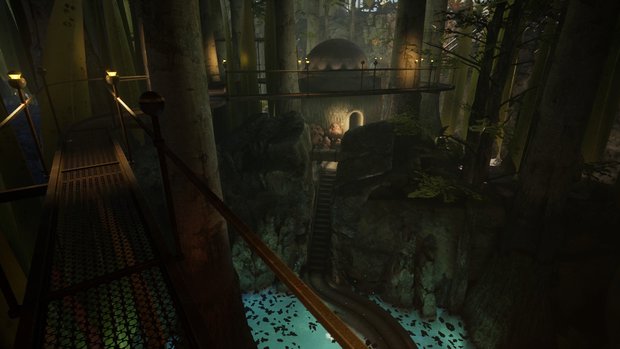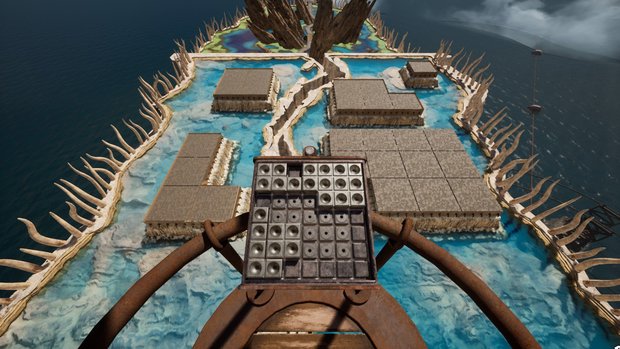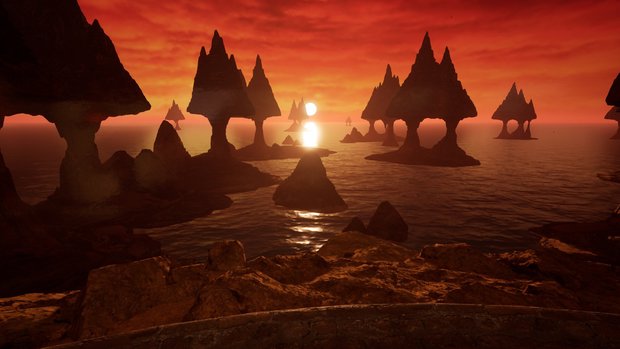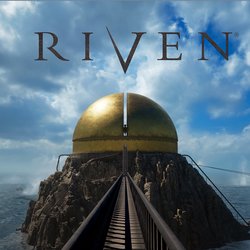Riven review

- 1 Comment
For those feeling torn, Cyan’s venerable classic returns as the definitive Riven experience in beautiful free-roaming 3D
It’s 1997. The golden age of adventures is coming to an end. Anticipation is high for the follow-up to the most successful adventure game of all time. When Cyan Worlds released the original Riven: The Sequel to Myst, it was with a different design ethos that took it from being just another game to an experience. Now, nearly thirty years later, the gaming landscape has changed considerably, and Cyan is back with a new, real-time 3D take on that experience. (A VR mode is also available, though this review is based solely on the standard version.) It’s every bit as demanding and puzzle-intensive as ever, refusing to ever hold your hand, so if that doesn’t appeal to you, the new version won’t win you over. But the world (re-)created here is more lush and stunning than ever before, with new puzzle pieces to play with as well. Those who enjoyed the first game or are wondering what all the fuss was about, it’s a welcome return to “the surrealistic adventure that [becomes] your world.”
When the original Riven was released, it was already visually stunning, though still presented in the same pre-rendered slideshow style as its predecessor, as 3D graphics at the time were nowhere close to being that highly detailed. Over the years, that visual gap has closed as modern game engines are now able to present that level of clarity and more. So the new Riven gets to benefit from both the modern technical advances and the sheer level of detail that the original release offered. (Although oddly, the one minor detail marring the updated aesthetic is the old Mac-inspired white grabbing hand cursor that is usually hidden but always a little jarring when it appears in its now heavily pixelated form).
Riven takes place in a single cohesive world spread across five neighbouring islands in an endless sea. This was a big change from Myst, which gave players five wholly unique, self-contained worlds (“Ages” in Myst-speak). Where Myst went for breadth, Riven goes for depth. There is so much more to see in these islands than any of the Ages in Myst. The scope is very quickly revealed at the start of the game, when players are deposited on the first of the islands, where roughhewn steps cut into the rock spiral up to a massive golden dome and the sun glints from its metallic surface. Looking beyond it to the sea, great cracks can be seen, into which water endlessly pours, sending up a white mist, because the islands of Riven exist in an Age that is unstable.

While not heavily story-driven, there’s plenty of background lore to Riven. The D’ni were a race of humans that long ago learned the art of writing mystical books that could link to other worlds. Once linked, the books took over the destiny of those Ages, and changes to the books were manifested in the worlds themselves. But the D’ni civilization fell and the art was lost. Until, that is, one surviving child, Gehn, returned to the heart of the D’ni civilization, hidden somewhere below the desert of New Mexico. There he taught himself how to write worlds, but his approach was flawed and those flaws carried into the changes he made. Such was the fate of Riven. When you arrive it is a world that is falling apart because of what Gehn wrote. The cracks in the oceans and the occasional tremors that rock the islands are testament to his inabilities.
As a consequence of these failings, Gehn’s son Atrus, first introduced in Myst (and played by Cyan’s Rand Miller) carefully laid plans to trap Gehn in Riven without the supplies to write more books and endanger more civilizations. Unfortunately, the people of Riven were also trapped in the decaying world, including Atrus’s wife, Catherine. Now it’s all Atrus can do to write changes into the Riven book to keep the Age from falling apart. Fortunately Atrus met you, which provides him the ability to continue working on the book while sending you to this other world to stop Gehn once and for all, free Catherine, and help the people of Riven move onto a more stable Age.
Bits and pieces of this narrative are revealed throughout the course of your experience. Back in the day, Riven released on an almost unheard-of five CDs. Even with that many discs, there were limitations to the amount of data that could be crammed in, which expressed itself most noticeably in the torturous amount of disc swapping needed. At that time, interactions with people were presented via full-motion QuickTime videos. By today’s standards, those were painfully limited with huge compression artifacts and occupied a large space footprint on those five discs, which meant only a scant few conversations with actual people.

Instead, most of Riven’s story was presented via various written journals and notes scattered about the world. Players could find books by Atrus, Gehn, and Catherine, each of them – over the span of up to twenty to thirty pages – doling out a part of the backstory. It was here that the broader Myst mythology began to take shape, one that would continue into the subsequent games as well as a series of three novels. Of those real-world books, The Book of Atrus is the most important, at least as far as both Myst and Riven are concerned, as it serves as a direct prequel to both. To get the most narrative juice out of Riven, explorers to that strange land should definitely track down and read The Book of Atrus first.
And a strange land it is indeed. The original Riven released at a time where developers were still falling over themselves to make games as fiendishly difficult as possible. Riven took the tack of dropping players into a completely new world with almost no direction on what to do, or context for what was going on. Imagine travelling half way around the world to a culture that you have never encountered before. You have no guide. There is no one to ask questions of, and even if there were, you would not comprehend the language enough to understand the answers. All of that is to say: Riven is hard. Very hard.
Myst was hard too, but it presented a steady stream of puzzles throughout, with quite a wide variety. Riven really only has three or four mega puzzles, but they’re so layered they require gathering many pieces of disparate information strewn across the different islands. Not only do explorers have to find that information, they have to figure out how it’s all connected. For example, at one point a door to an underground secret society known as the Moiety needs to be opened. This will require studying the wildlife of Riven; learning not one but two different numbering systems – the second being a new addition to the remake; finding and aligning markers scattered by the Moiety across the islands, which includes breaking into Gehn’s lab (a whole puzzle sequence in its own right); learning to view the Moiety’s equivalent of blacklight symbols; and solving mini challenges to make each of those symbols visible in the first place. Oh, and getting a village submarine working and using various levers, buttons, and other mechanical contraptions just to make a path to the door that needs to be opened in the first place.
The puzzles in Riven are certainly not the type you’ll solve in an afternoon. Or possibly even a week, if you play it as it was originally intended, with no walkthrough by your side. You will uncover some new secret and think you’ve had a eureka moment, only to realize you have no idea what it means. You will mull over abstract clues, or details that may not even be clues. You will get up from your computer and go for a walk, feeling hopelessly stuck. You will come back days later with some new revelation to confirm or some new plan to try. When you experiment, there is no guarantee of success, and if you get an attempted solution wrong, there’s no feedback to clue you in as to where your ideas went off track. For me, returning to Riven already armed with a notebook of copious notes, it still took in excess of eleven hours to reach the end, because the remake includes new puzzle details that makes solving them a different if not entirely new experience.

That may sound painful, but not when it’s such a pleasure to simply wander around and see the many gorgeous sights. Moving beyond the great golden dome of the first island, you will take a sky tram to the central island, where the people of Riven live. That journey is now gloriously high-resolution all the way. The main island has the Rivenese village, set in a water-filled caldera with people’s homes held aloft on birchwood pilings. Buildings are rounded mud houses. The villagers have been warned of your arrival and are nowhere to be seen. In the original game, you could catch glimpses of people running for cover in the distance. These have been removed, presumably because characters are now represented by 3D models that aren’t realistic enough to avoid the uncanny valley. Fortunately you only meet the prominent players Atrus, Catherine, and Gehn, and then only for brief periods.
Beyond the village is the jungle, with dappled light coming down through the branches of alien trees. Unusual wildlife inhabits the island, from sunbathing miniature plesiosaurs, to flights of butterflies with a secret, to the great wahrks – part whale, part shark, part bull – inhabiting the dark waters. More trams and a mining cart allow access to even more islands with even more sights, like a massive stump of a tree that has been hollowed by Gehn’s followers to form a prison. Speaking of Gehn, explore far enough and you’ll find a pocket Age that he has managed to cobble together where the sun is always setting and casting molten rays of light on a troubled sea.
Longtime fans who got the old big box release of Riven will remember its striking cover art: a massive beehive dome of a city with glowing orange windows held aloft by an impressive tree sprouting from a lake with water like black glass – the Age of Tay, as linked to by Catherine. In the original release, apart from seeing it at a distance from the outside, it was never a space that could be explored. Now a new stroll through the city interior has been added, as dark and mysterious as the box cover hinted at.

The promenade through Tay is quite short, but that’s in keeping with the other modifications that have been made for the remake, such as the simplification of certain puzzles and the streamlining of some navigation (no more switching submarine paths back and forth). The experience has been tweaked to present some new, never-seen-before elements, but on the whole remains faithful to the original.
You could easily spend hours just taking in Riven’s sights without engaging with anything more than a few minimal interactions needed to move from one island to another. In fact, the first puzzle you truly have to solve isn’t even encountered until you reach the third island, where you must find your way through a boiler at the bottom of a ravine to reach Gehn’s lab at the top. Cyan has designed it all so you can approach it how you want to. If all you want to do is be a virtual tourist until it’s time to get down to business, then that’s all you have to do. Or if you want to peel back the onion-like layers of the world a bit at a time, that’s open to you as well.
Of note, now that the world is in real-time 3D, is that it does take longer to get from place to place than in the original version, where you could quickly click through a series of screens in rapid succession. Movement speed is important, as the nature of the puzzles is such that you will do a lot of backtracking as you try to determine which elements fit together from across the entire world. To help mitigate the longer travel times, the game does allow you to run and, even better, provides a toggle run button so you don’t have to hold down the run key the entire way.
Another addition that might reduce the need to revisit places is the new screenshot system. At the touch of a button, it’s now possible to take a picture of what is currently displayed, and another button opens a menu where all collected photos are listed as thumbnails for clicking on to display them in full. This can be a useful for keeping track of visual details in the environment, but once you’ve displayed a full-sized screenshot you can’t simply move slideshow-style through the others. Instead you have to back out to thumbnails and scroll down to where you were again before accessing the next. It’s clunky, and as such, good old-fashioned pen and paper notes might still be the preferred way to go.
As much as this world is a visual triumph, it’s also an exploration in sound. Be sure to crank the volume as there are some moments where the bass kicks in and the rumbling rattles the pictures on the walls wherever spinning orb chambers have been installed. In the original game, each of these orbs was the same, providing access to the linking book to Gehn’s world. Now they serve as entry points into the starry expanse at which Atrus got a fleeting look at the start of Myst. There’s plenty more to listen to as well: the wind and the waves and the wildlife of Riven as bugs buzz, animals grunt, and the various mechanical contraptions scattered about the islands whirr and clank and grind. With everything now presented in a real-time 3D world, all these sounds are positional as well, moving around as you turn and stride through the environment. Most of the audio is left to the ambient soundscape around you, but the minimalist score is back as well, serving to accent key emotional moments and locations.
Final Verdict
Riven is back. And like the original release, players need to go in with a different mindset from that of other adventure games, even the rest of the Myst series. It is not a string of self-contained puzzles to solve. It is not a narrative to be followed. Those elements do exist, yes. But what Riven is most is an experience. A hard experience. A potentially looong experience if you don’t peek at a walkthrough. An experience of immersion into another world that is almost completely opaque to start, which is guaranteed to frustrate some players encountering it for the first time, just as it did back in 1997. For those who persevere, it is an experience that eschews instant gratification and rewards patience. An experience that requires explorers to poke into every nook and cranny, admire every scenic view and listen attentively to every sound. To pull together disparate strands of seemingly unrelated facts and information, and weave those together in your mind until solutions present themselves. Already an experience like no other, this new 3D Riven remake is now an experience unlike even its former self. Some longtime fans may miss the puzzle elements or simplified controls that have been removed, simply because that’s the experience they remember and cherish. For everyone else, this is now the definitive Riven experience, whether playing again or for the first time.
Hot take
Riven is not a game, it is an experience. It’s a demanding, puzzle-intensive experience that isn’t for everyone, but with its gorgeous setting and a web of interconnectedness never seen before in free-roaming 3D, be prepared to make this remastered edition your world for a long time before you come out the other side, even if you’ve played the original.
Pros
- Gorgeous environments filled with evocative sounds
- Intricately layered puzzles
- The start of the broader Myst mythology
- Tweaks to the world means there’s new stuff to discover for long timers
Cons
- Character models slip into the uncanny valley
- New screenshot system is a little cumbersome
Richard played Riven on PC using a review code provided by the game's publisher.











1 Comment
Want to join the discussion? Leave a comment as guest, sign in or register.
The "free roaming 3d" thing isn't all its cracked up to be. Credit to cyan for reproducing the original so well, except the bad character models (although keeping the original voice acting was great). I was very impressed with the sound effects and ambience. Going 3d means risking that papery and low contrast look compared to the impressive cgi stills in the original. Thankfully they've upped the contrast which you can see in scene comparisons online and there's a great deal of texture detail in the original that now has actual displacement like rocks and cliffs, instead of just being a flat surface. But visuals aside, I'm not really sure what the benefit is to 3d, as getting a little lost in the original and not being able to run around was strangely more immersive to me. I didn't like the new puzzles, especially the eyeglass thing which felt stolen from The Room (a good game by itself but totally different vibe). I also thought the weird dome bridge stuff felt totally out of place. The book animations are better than what we saw in the Myst remake, but they still suck and the pages flip out far too quickly with almost no curvature which (and this seems pedantic I know) irks me especially as the series revolves around the books. I'd have almost preferred the original's instantaneous slides to bad animations here, or a control to slow it down. Despite these problems, this is still a great way to experience the environments and story and atmosphere and its clearly a very high value game worth playing.
Reply
Leave a comment